Russian knapweed Biocontrol
What is Russian knapweed?
Russian knapweed (Rhaponticum repens) is a clonal perennial forb in the Aster family. It was accidentally introduced in the United States during the late 1800s via alfalfa seed. Russian knapweed originates from countries bordering the Caspian Sea in western Asia; also China and Mongolia. It is now found throughout the United States west of the Appalachians and is most problematic in the semi-arid rangelands of the Great Basin and the Rocky Mountains. Russian Knapweed seed is often transported to new locations in the stomachs of grazing animals. If horses consume too much, it can cause neurological disease, equine nigropallidal encephalomalacia.
How to Identify Russian Knapweed
Russian knapweed forms dense monocultures in disturbed lands. It is a bushy 1-3 ft. tall plant with clonally spreading roots. Near the root crown, roots are covered in a black scaly sheath that separates it from other knapweeds. Solitary pink/purple flowers grow at the tip of leafy branches. Lower leaves are 2-4 in. long and lobate while upper leaves are about 1 in. long and lanceolate. In contrast, other knapweeds have more deeply lobed (pedate) lower leaves.
Effects of Russian Knapweed
Russian knapweed is an aggressive, non-native plant that can dominate the landscape, due in part, to US populations producing nearly four times more seed (1200 seeds per plant) than in native populations. It has no agricultural or ecological value. Russian knapweed out-competes crops, degrades rangeland, and causes reduced biomass of native vegetation, negatively affecting the ecology of our wildlands. In many instances, Russian knapweed is so widespread on low-value land that the use of herbicides is uneconomical and detrimental to the environment.
Biological Control
Biological control of weeds is the use of natural enemies such as insects, mites, pathogens or other animals to reduce the spread, reproductive ability, or reduce the density of the target weed. The state of Colorado is fortunate to have a large and active program that works with biological control agents on many problematic pest species in the state and operates out of an insectary in Palisade. It is at this location that Russian knapweed insects are collected, reared, and distributed throughout the state.
There are currently two biological control agents approved for release on Russian knapweed in the US. The two biocontrol agents are the gall midge, Jaapiella ivannikovi (Cecidomyiidae), and the other is a gall wasp, Aulacidea acroptilonica (Cynipidae).
Life Stages of the Gall Wasp
Size of sesame seeds the stem gall wasps (A) are early season insects emerging from stem galls (B) in mid to late Spring. The female adults lay eggs in the main and lateral shoots causing pea-like swellings (C-D) as larvae hatch within stems. Developing larvae (E) deprived the nutrient source of the plant. The wasps overwinter in stems as late instar larvae (F) and pupate inside galls in early Spring. This agent has one generation a year. A small number of larvae can pupate after a second winter. The wasps will not sting people or wildlife.
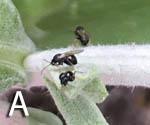


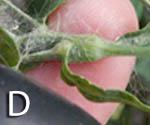
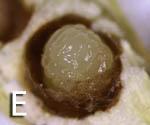
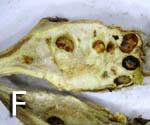
FAQ (Gall Wasp)
Plot Size
- Minimum 1/8 acre Rk infestation (less than 1/8 acre infestation is too small for release). Another visual example is 25 meters by 25 meters plot or 27 yards by 27 yards.
- If plot size is around 1/8 acre then surrounding infestations needed nearby for these moving organisms.
- No concerns on sites being too large.
Site Recommendations
- Locate an area with no disturbance.
- Avoid chemical use, mowing or plowing, and heavy grazing.
- The site requires very low management after release. The gall wasps will fly, move by wind, or catch a ride on wildlife to move around the infestation.
Release Methods and Site Care
- Release in the center of the Rk infestation.
- Optimal plant height to release on is 4 to 6 inches.
- New forming galls observed approximately 2 weeks after release.
- Flag the point of release (POR) and new forming galls. This will give you a good census on the spread of the biocontrol. Tip: use a 4 - 6-foot fence post to mark POR and flagging new forming galls.
- Please be cautious on stepping on Rk stems due to potential gall development in future site checks.
- Take photos pre and post-release.
Take GPS waypoint of POR.
Life Stages of the Gall Midge
The midge originates from countries neighboring western China. It can complete up to five generations in a growing season, each generational cycle requiring 28 days. Females mate soon after becoming adults in spring (A) and seek out young, tender knapweed plants to lay eggs. Eggs are placed on the surface of growing bud tips (B). Developing larvae feed on the plant through three larval stages (C). This feeding causes the stem to stop growing and form a rosette gall of fused leaves (D,E). Larvae develop in silky webs between the growing leaves of the gall (F). There can be up to 14 larvae protected inside each gall where they will hibernate in the pupal stage (G) and emerge once again in the spring.
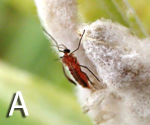
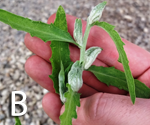
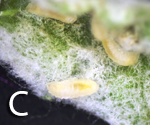
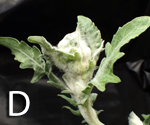
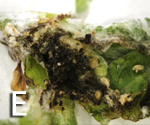
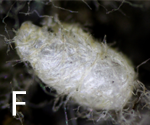
FAQ (Gall Midge)
How Does It Work?
Feeding of the midge larvae induces gall formation that stunts stem/branch growth resulting in a significant reduction of Russian knapweed shoot length (10−20%) and overall shoot biomass (20−25%). This reduced plant vigor allows for competition by native vegetation. Galls also prevent plants from flowering, resulting in significantly reduced seed production. Many infested plants fail to produce any viable seed at all. The goal of gall midge release is to slow the rate of Russian knapweed spread, prevent the colonization of new sites by reducing seed production, and reduce Russian knapweed biomass in existing infestations.
How long will it take?
Biological control is rarely used as an eradication method and our agents do not directly kill the target weed. As with all other weed control methods, these agents take some time to have significant long-term impacts. Because they are biological controls, and thus living organisms, each insect release trial can vary greatly in the establishment, population build-up, and target weed impact. Biological control works to slowly bring the local ecosystem back in balance by reducing the competitive ability of the target weed. This is a process that is safe, effective, inexpensive, and sustainable but can take years of patience to achieve. It is one option within the integrated pest management scheme and is ideal in large infestations of Russian knapweed.
What else does the agent attack?
As current biological control practices dictate, the agents we release are extremely host-specific and will only target Russian knapweed. This insect is safe and will not affect humans, livestock, or other plant species…even if host plants become difficult to find. Extensive host specificity testing is conducted on potential agents across several years before it is released on its target weed. If an agent is not host-specific enough, it does not get approved to be released.
How do I apply the agent?
Russian knapweed controls are best released in April-June when new plant growth is still common. We will ship rosette gall bouquets to place in a shaded portion of the infestation where adult midges will emerge and begin establishing a population on your target weed.
Comparison of Gall Midge & Wasp